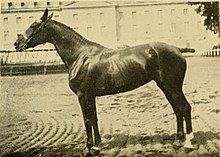Conservation status extinct | Other names Charollais | |
 | ||
Similar Berrichon horse, Limousin horse, Nivernais horse, Anglo‑Norman horse, Auvergne horse | ||
The Charolais or Charollais is an extinct breed of warmblood horse from the Charolais region of France surrounding the town of Charolles, now in the Saône-et-Loire department of Burgundy, in eastern central France. Like other French warmbloods, it was the result of crossing local agricultural horses with the Thoroughbred, and was known by the name of the region in which it was bred. The Charolais never had a breed-specific studbook. The Charolais and other French warmblood breeds were fused in 1958 to create the national warmblood studbook for a unified breed, the Selle Français. It was originally used as a multipurpose horse for riding, driving, and agriculture. During the late 19th century, additional Thoroughbred blood was added and a new type emerged that was principally used as a light cavalry mount. It was also used for dressage and show jumping.
Contents
Characteristics
The Charolais breed was small, and most closely physically resembled the Morvan horse, another now-extinct French type. The breed had a short head with small ears and a short, strong neck attached low on the shoulder. The body was short and rounded, with a broad croup and strong legs. They were generally considered to be small and inelegant. They were strong, robust and hardy, the last of these traits especially so before the breeding changes of the 19th century, and were known for their pulling power.
The Charolais was appreciated for its gaits and endurance. It was known for its ability as a cavalry horse, and in 1933 was called a perfect war horse. It was also used for dressage and show jumping, and members of the breed competed in international events in these sports. It was considered to be a better galloper than the Anglo-Norman horse, another French breed.
History
The original landrace ancestors of the Charolais include the Cheval Bourguignon (Burgundy Horse), which developed from horses bred in the Burgundy region in the Middle Ages. Although small, Burgandy horses were known for their endurance and robustness. They were used for riding and agriculture, and as coach horses. This type, combined with other blood, developed into the Charolais, which belonged to a group of French breeds called demi-sang or "half-bloods"—crosses between native breeds and Thoroughbreds. Some 19th and early 20th century sources claim that Arabian blood was also added from horses captured from the Saracens after the Battle of Poitiers.
Until the mid-20th century, the Charolais and other demi-sang breeds, such as the Angevin, the Charentais, the Cheval Limousin and the Vendéen, were generally known by the name of the region in which they existed, and did not have individual breed studbooks. As these horses were not separated by breed type, but instead by geography, there were no significant physical characteristics that distinguished the Charolais from other demi-sang types that developed prior to the mid-19th century. Charolais horses were primarily raised in what is now the Saône-et-Loire department. The areas of Cluny, Charolles, Blanzy, Paray-le-Monial and Digoin were preferred for breeding, due to the clay-limestone soils that favored the development of the equine skeletal structure.
Multi-purpose types like the Charolais and the Morvan were slowly supplanted in farmers' favor by draft horses. The Nivernais breed, in particular, was preferred by farmers and threatened the existence of the Charolais. Thus, the original small multi-purpose strain of Charolais gave way to a type of small draft horse that was next crossed with purebred and crossbred Thoroughbreds until, by 1850, it had become a horse for cavalry purposes. It was thought by some enthusiasts, however, that this outcrossing reduced the quality of the breed, and many missed the old-style Charolais, which had disappeared due to a lack of demand and use. However, others thought that the outcrossings had benefited the Charolais breed: in 1919, one author stated that the breeding of the Charolais type was in excellent condition, and a report from the time stated that the favorite horse of King Albert I of Belgium was a Charolais named Titanic.
Like many other French saddle horse types, in 1958 the Charolais was part of a reorganization of French horse breeding. Multiple demi-sang types, including the Charolais, were merged to create a new national breed called the Selle Français, or French Saddle Horse. The Selle Français has been called "one of the finest sport horses today", and is seen in international competition in show jumping, as well being used for events such as dressage, three-day eventing and racing.
